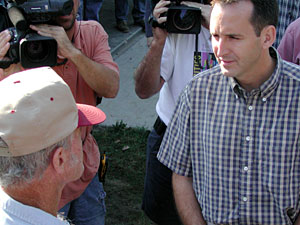|
Audio
Photos
More from MPR
Your Voice
|
Pawlenty tours drought-stricken fields
September 9, 2003
 |
| Gov. Pawlenty chats with a Mazeppa farmer during a stop on his tour of drought-stricken southeast Minnesota. (MPR Photo/Rob Schmitz) |
Mazeppa, Minn. — Mazeppa farmer Dale Stensland says as of the Fourth of July weekend, things were looking good this year. Area farmers anticipated another bumper crop. But then, he says, trouble loomed.
"It stopped raining and the ground was wet enough to hold it 'til the end of July and then we needed rain in the first part of August and we didn't get it. And since then it progressively got worse," he says.
 | |||
It's so bad, Stensland says, that looking at much of southeastern Minnesota's crops you might think it's the middle of October, not September.
"Soybeans are burnt right down to nothing. Corn is fired from the bottom up. If there are any ears on those high knolls, they're real shriveled. They're maybe only five-inches long, and the first three inches have corn on them, and then they go down to nothing," according to Stensland.
Stensland farms over 400 acres of corn and soy. He estimates his yield will be down at least 25 percent over last year. Financially, he says, he'll be lucky if he breaks even. The same is true for many farmers in over 50 of Minnesota's 87 counties. Crop loss in Minnesota is estimated at more than $1 billion.
Stensland was one of over two dozen farmers who met with Gov. Tim Pawlenty and state Agriculture Commissioner Gene Hugoson. The governor's team was led through rows of parched, brown corn to inspect the damage. The information they're gathering will end up in a state application for federal assistance.
Gov. Pawlenty says federal aid and crop insurance will be just the beginning of help for the state's drought-stricken farmers.
 | |||
"We're going to have to do an assessment of how severe the damage is and what this means to our farmers' ability to stay in business and if there are remaining gaps, we may have to address them legislatively, as we have in the past with these times of crisis," Pawlenty said.
Hugoson says if approved, federal assistance will come in the form of low-interest loans from the U.S. Department of Agriculture. Hugoson says congressional help is also a possibility, but not likely.
"When you have only a region that's affected by a disaster such as we have this year, it's not as easy to get something through, as if you've got a more widespread route throughout the whole country. There's less congressional leverage to do something like that, so the chances of something happening and in view of what's happening to the federal budget as well makes it more difficult," according to Hugoson.
Hugoson says the state will send the application for federal aid by the end of this week. It will take the USDA up to 60 days to decide whether to approve it.
|
News Headlines
|
Related Subjects
|
